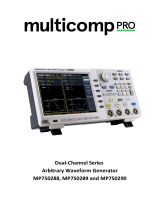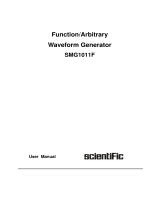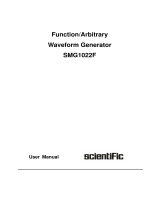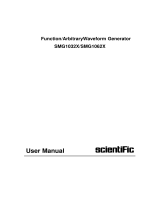Page is loading ...

- AWG Series Function/Arbitrary Waveform Generator
User Manual
AWG Series Function/Arbitrary Waveform Generator
AWG-4105/AWG-4110/AWG-4150

- AWG Series Function/Arbitrary Waveform Generator
General Safety Summary
Review the following safety precautions to avoid injury and prevent damage to this product or any
products connected to it. To avoid potential hazards, use this product only as specified.
Only qualified personnel should perform service procedures.
To Avoid Fire or Personal Injury
• Use proper power line. Only the special power line of the products approved by the state should
be used.
• Ground the instrument. This generator is grounded through the protective terra conductor of the
power cord. To avoid electric shock, the grounding conductor must be connected to the earth
ground. Make sure that the instrument is properly grounded before connecting the input or
output terminals.
• Observe all the ratings of the terminal. To avoid fire or shock, observe all the ratings and
symbols that marked on the instrument. Read the user guide carefully before making
connections to the instrument.
• Do not operate without Covers. Do not operate the product with covers or panels removed.
• Avoid circuit or wire exposed. Do not touch the exposed connections or components when the
power is on.
• Do not operate with suspected failures. If you suspect there is damage with this product, you
should have it inspected by qualified service personnel authorized by AKTAKOM before
further operations.
• Provide proper ventilation.
• Do not operate in wet/damp conditions.
• Do not operate in an explosive atmosphere.
• Keep the product’s surfaces clean and dry.

- AWG Series Function/Arbitrary Waveform Generator
Terms on the product. Terms below may appear on the product:
DANGER:Indicates an injury or hazard that may immediately happen.
WARNING:Indicates an injury or hazard that may not immediately happen.
CAUTION:Indicates that a potential damage to the instrument or other property might occur.
Symbols on the product. Symbols as followed may appear on the product:
Safety Terms and Symbols
Terms in this guide. These terms may appear in this manual:

- AWG Series Function/Arbitrary Waveform Generator
Introduction of AWG Series
The manual covers the following 3 types of AWG Series Function/Arbitrary Waveform Generators:
AWG-4105/AWG-4110/AWG-4150
AWG Series Function/Arbitrary Waveform Generators adopt the direct digital synthesis (DDS)
technology, which can provide stable, high-precision, pure and low distortion signals. Its combination
of excellent system features, easiness in usage and versatile functions makes this generator a perfect
solution for your job now and in the future.
AWG Series Function/Arbitrary Waveform Generator has a clear and simple front-panel. The user-
friendly panel layout and instructions, versatile terminals, direct graph interface, built-in instructions
and help system have greatly simplified the operation process, with the help of which, users do not
have to spend a great deal of time learning and familiarizing the operation of the generator before they
can use it proficiently. The built-in AM, FM, PM, ASK, and FSK modulation functions generate
modulated waveforms at ease, without the help of a separate modulating source. USB I/O is a standard
accessory, while LAN and GPIB are optional. Remote instructions meet the SCPI specification
requirements.
From the characteristics and specifications given below, you will understand how AWG can satisfy
your requirements.
• DDS technology provides precise, stable and low distortional output signal.
• 3.5 TFT color LCD display.
• 125MSa/s sampling rate, 14-bit resolution.
• Frequency characteristics:
Sine: 1uHz to 50 MHz Square:
1uHz to 25 MHz Ramp: 1uHz
to 300 kHz Pulse: 500uHz to
10MHz
White Noise: 50MHz bandwidth (-3dB)
Arbitrary: 1uHz to 5MHz
• 5 standard waveforms: Sine, Square, Ramp, Pulse, Noise
• Self-defined arbitrary waveform
• Multiple modulation function, various modulated waveform: AM, FM, PM, ASK, FSK, Sweep
and Burst.
• Multiple I/O: external modulation source, external 10 MHz reference input, external trigger
source, waveform output, synchronous signal output.
• Support USB storage device. Software updating could also be performed using USB devices.
• Up to 16k sample points of internal waveform depth, which can rebuild or simulate any complex
waveform.
www.tmatlantic.com - AWG Series Function/Arbitrary Waveform Generator
• Remote control is realized using the USB.
• Multiple interfaces: USB host & device, GPIB (IEEE-488) (option) , LAN. (option)
• Support the seamless connection with AKTAKOM Series Digital Oscilloscopes; Can directly read
and rebuild the stored waveform in the oscilloscopes.
• 2 languages (English and Chinese) user interface and built-in help system.

- AWG Series Function/Arbitrary Waveform Generator
Chapter 1 Getting Started
This chapter covers the following topics:
General Inspection
Handle Adjustment
The Front/Rear Panel
To Set a Waveform
To Set Modulate/Sweep/Burst
To Set Output
To Use Digital Input
To Use Store/Utility/Help Function

- AWG Series Function/Arbitrary Waveform Generator
General Inspection
When you get a new AWG Series Function/Arbitrary Waveform Generator, you are
suggested to take the following steps to inspect the instrument.
1. Inspect the shipping container for damage.
If there are damages in the packing or foam, keep them until the whole machine and the
accessories pass the electric and mechanical testing.
2. Check the accessories.
Accessories supplied with the instrument are listed in chapter 6 "Appendix A: Accessories".
If the contents are incomplete or damaged, please notify your AKTAKOM sales
representative.
3. Inspect the instrument.
In case any mechanical damage or defect, or if the instrument does not operate properly or
pass performance tests, notify your AKTAKOM sales representative. If the shipping
container is damaged, or the cushioning materials show signs of stress, notify the carrier as
well as your AKTAKOM sales office. Keep the shipping materials for the carrier’s
inspection. AKTAKOM offices will arrange for repair or replacement at AKTAKOM’s
option without waiting for claim settlement.

- AWG Series Function/Arbitrary Waveform Generator
Handle Adjustment
To adjust the handle position of AWG Function/Arbitrary Waveform Generator, please grip the
handle by the sides and pull it outward. Then, make the handle rotate to the desired position.
Figure 1-1 Viewing Position and Carrying Position

- AWG Series Function/Arbitrary Waveform Generator
The Front/Rear Panel
When you get a new AWG Series Function/Arbitrary Waveform Generator, first you need to
understand how to operate the front/rear panel correctly. This chapter will make a brief
introduction and description for the operation and functions of the front/rear panel.
The AWG Series Function/Arbitrary Waveform Generator has a clear and simple front panel. See
Figure 1-2 and Figure 1-3. The front panel has a knob and functional keys. The 5 blue grey
buttons on the right side of the screen are menu buttons (named F1 to F5 from up to down) with
the help of which, you can enter different functions menu or have direct specific applications.
The signal input and output interfaces are set at the front and rear panels which can help
generating multiple arbitrary waveforms. The various interfaces can meet the need of the
multiple interface communications.
Figure 1-2 Front Panel of AWG Series

- AWG Series Function/Arbitrary Waveform Generator
Figure 1-3 Front Panel of AWG Series
Figure 1-4 Rear Panel of AWG Series

- AWG Series Function/Arbitrary Waveform Generator
Waveform
Display Window
Parameter
Display and
Editing Window
Operation Menu:
Different functions
have different menus
Figure 1-5
Display Interface (Sine Wave is the default display signal)
Character definitions in this User Manual:
The signs for buttons in this manual are the same as the panel buttons. Please note that, the signs
for the functional buttons on the operation panel are represented by squared words, such as
Sine , which represents the transparent functional key with Sine on it on the front panel, while
the menu buttons are represented by brighten words such as Freq, which means the frequency
option in the Sine menu.

- AWG Series Function/Arbitrary Waveform Generator
To Set a Waveform
On the operation panel, there is a set of buttons with waveform icon. See Figure 1-6. The
exercise below will help you familiarize with the waveform selection settings.
Figure 1-6 Waveform Selection Buttons
1. Press Sine button and the waveform window will display sine waveform. AWG
Series Generator can generate sine signal with a frequency from 1µHz to 50MHz. By setting
frequency/period, amplitude/high level, offset/low level, sine signal with different
parameters can be generated.
Figure 1-7 Sine Signal Display Interface
As shown in Figure 1-7, the default signal parameters are: 1 kHz frequency, 4.0Vpp amplitude
and 0Vdc offset.
2. Press Square button, and the waveform window displays square waveform. AWG
Series Generator can generate square signal with a frequency from 1µHz to 25MHz and
variable duty cycle.

- AWG Series Function/Arbitrary Waveform Generator
Figure 1-8 Square Signal Display Interface
As shown in Figure 1-8, the default signal parameters are: 1 kHz frequency, 4.0 Vpp amplitude,
0Vdc offset and 50% duty cycle.
3. Press Ramp button, and the waveform window displays ramp waveform. AWG
Series Generator can generate ramp signal with a frequency of from 1µHz to 300 kHz and
variable symmetry
Figure 1-9 Ramp Signal Display Interface
As shown in Figure 1-9, the default signal parameters are: 1kHz frequency, 4.0 Vpp amplitude,
0Vdc offset and 50% symmetry.
4. Press Pulse button, and the waveform window displays pulse waveform. AWG Series
Generator can generate pulse signal with a frequency from 500µHz to 5 MHz and variable
pulse width and delay

- AWG Series Function/Arbitrary Waveform Generator
.
Figure 1-10 Pulse Signal Display Interface
As shown in Figure 1-10, the default signal parameters are: 1 kHz frequency, 4.0Vpp amplitude,
0Vdc offset, 200µs pulse width.
5. Press Noise button, and the waveform window displays noise waveform. AWG
Series Generator can generate noise signal with a band width up to 50 MHz.
Figure 1-11 Noise Signal Display Interface
As shown in Figure 1-11, the default signal parameters are: 4.0Vpp amplitude and 0Vdc offset.
6. Press Arb button, and the waveform window displays arbitrary waveform. AWG Series
Generator can generate repeatable arbitrary waveform signals with at most 16K points and
5MHz frequency.

- AWG Series Function/Arbitrary Waveform Generator
Figure 1-12 Arbitrary waveform Signal Display Interface As shown in
Figure 1-12, the default sine signal parameters are: 1kHz frequency, 4.0 Vpp amplitude and
0mVdc offset.

- AWG Series Function/Arbitrary Waveform Generator
To Set Modulate/Sweep/Burst
As shown in Figure 1-13, there are three buttons on the front panel, which are used for
modulation, sweep and burst settings. The instructions below will help you familiarize with the
setting of these functions.
Figure 1-13
Modulate/Sweep/Burst button
1. Press Mod button, and the modulated waveforms will be generated. The modulated
waveform can be changed by modifying the parameters such as type, internal/external
modulation, depth, frequency, waveform, etc. AWG Series can modulate waveform using
AM, FM, PM, ASK and FSK. Sine, square, ramp or arbitrary waveforms can be
modulated (pulse, noise and DC can not be modulated).
Figure 1-14 Modulated Waveform Display Interface
2. Press Sweep button, sine, square, ramp or arbitrary waveform can be swept (pulse, noise and
DC can not be swept). In the sweep mode, AWG Series generate signal with variable
frequencies.

- AWG Series Function/Arbitrary Waveform Generator
Figure 1-15 Sweep Waveform Display Interface
3. Press Burst button, burst for sine, square, ramp, pulse or arbitrary waveform can be
generated.
Figure 1-16 Burst Waveform Display Interface
Term Explanation
Burst: Output waveforms with set cycle times.
Burst can last for certain times of waveform cycle (N-Cycle Burst) or be controlled by
external gated signals (Gated Burst). Burst applies to all kinds of waveforms, but
noise can only be used in gated burst. Generally it is called burst function within every
signal generator.

- AWG Series Function/Arbitrary Waveform Generator
To Set Output
As shown in Figure 1-17, there are two buttons on the right side of the operation panel, which are
used to output control. The instruction below will help you familiarize with these functions.
Figure 1-17 Output Buttons
Press Output button, activate or deactivate the output signal.
To Use Digital Input
As shown in Figure 1-18, there are three sets of buttons on the operation panel, which are
direction button, the knob and the keypad. The instruction below will help you familiarize with
the digital input function.
Figure 1-18 Front Panel Digital Input
1. The up and down keys are used to shift parameters and the left and right keys are used to
shift digits.
2. Keypad is used to directly set the parameters value.
3. Knob is used to change a signal digit value whose range is 0~9. Clockwise to increase 1.

- AWG Series Function/Arbitrary Waveform Generator
To Use Store/Utility/Help Function
As shown in Figure 1-19, there are three buttons on the operation panel, which are used to call
the store/recall, utility and help function. The instruction below will help you familiarize with
these functions.
Figure 1-19 Store/Recall,
Utility and Help Button
1. The Store/Recall button is used to store waveform data and configure information.
2. The Utility button is used to set the auxiliary system function, change the output
configure parameters, interface setting, system setting information or perform the
instrument self-test and read the calibration information, etc.
3. The Help button is used to read the help information.

- AWG Series Function/Arbitrary Waveform Generator
Chapter 2 Operating Your Generator
Up to now you have got a brief understanding about AWG series with the front/rear panel,
every function control area and keys. You should also know how to set your Function/Arbitrary
Waveform Generator for your usage. If you are not familiar with these operations, you are
suggested to read chapter one “Getting Started” again.
This chapter covers the following topics:
■
Setting Sine Signal
■
Setting Square Signal
■
Setting Ramp Signal
■
Setting Pulse Signal
■
Setting Noise Signal
■
Setting Arb Signal
■
Output Modulated Signal
■
Output Sweep Signal
■
Output Burst Signal
■
Store/Recall
■
Utility Setting
■
Help System
You are suggested to read this chapter carefully so as to understand AWG
Series Generator’s versatile waveform setting functions and more operation
methods.

- AWG Series Function/Arbitrary Waveform Generator
To Set Sine Signals
Press Sine button to call the sine operation. The sine waveform parameters are set by using
the sine operation menu.
The parameters of sine waveforms are: frequency/period, amplitude/high level, offset/low level
and phase. Different sine signals are generated by setting these parameters. As is shown in Figure
2-1, in the soft key menu, select Freq. Cursor is located in the frequency parameter area in the
parameter display window, and users can set the frequency value here.
Figure 2-1 Sine Parameter Display Interface
Figure 2-2 Table 2-1 Menu Explanations of Sine Waveform
Function
menu
Setting s
Explanations
Freq/
Period
Set the signal frequency or period;
The current parameter will switch at a
second press.
Ampl/
H Level
Set the signal amplitude or high level;
The current parameter will switch at a
second press.
Offset/
LLevel
Set the signal offset or low level;
The current parameter will switch at a
second press.
Phase/
EqPhase
Set the phase of the signal;
The current parameter will switch at a
second press.
/



